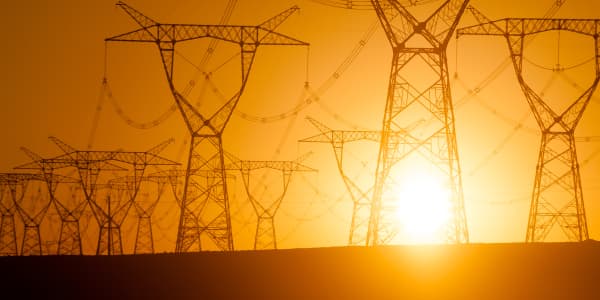President Obama's proposal to fight climate change by cracking down on carbon emissions from coal-fired electricity plants may raise consumers' bills in some parts of the country, but it will probably have a limited effect on investors, stock and bond analysts say.
The proposal, announced Monday by Environmental Protection Agency administrator Gina McCarthy, is more limited than some had feared. It calls for a 30 percent reduction in carbon emissions from power plants, compared with 2005 levels, by 2030. An analysis by the U.S. Chamber of Commerce that said the proposal would raise bills by $17 billion a year but assumed the administration would demand a 42 percent cut in emissions.
Indeed, half of the administration's targeted decline in carbon emissions has already been achieved, according to data from the U.S. Energy Information Administration. The nation's power plants spit out 15 percent less carbon in 2012 than in 2005, from 2.54 billion metric tons in 2005 to 2.16 billion tons, the EIA said.
Before the report, Morningstar utilities analyst Travis Miller said a key factor in the impact of the rules would be the so-called "base year"; because carbon emissions peaked around 2005, utilities would find it easier to meet the required reduction if the rules mandated cuts from 2012 emissions, he said. Also crucial: Utilities would have an easier time complying if states were allowed to try different strategies to meet the standards, he said.
"It turned out to be very flexible, and that's the key,'' said Charles Fishman, another Morningstar utilities expert, on Monday, explaining that "2005 was a prerecession year and before the shift to natural gas. The minor surprise is that EPA is giving states more flexibility than you would expect. "
That will let states craft plans that mix promotion of efficiency measures to curb power demand, renewable energy sources and even more switching to gas from coal, he added.
Since 2005, coal's share of U.S. electricity has fallen to 39 percent from 50 percent, even including a move up in 2013, according to EIA data. Usage of coal hit bottom in 2012 at 37 percent, when gas traded for as little as $1.95 per million British thermal units of energy. The price of gas since has risen to $4.54 per million BTUs, as drillers backed off amid glutted markets that hurt their profits.
Read MoreUS unveils sweeping plan to slash power plant pollution
A carbon emissions scorecard
Emissions from energy consumption at conventional power plants and combined-heat-and-power plants
| Year | Carbon Dioxide<br>(thousand metric tons) | Sulfur Dioxide<br>(thousand metric tons) | Nitrogen Oxides<br>(thousand metric tons) |
|---|---|---|---|
| 2002 | 2,423,963 | 10,881 | 5,194 |
| 2003 | 24,45,094 | 10,646 | 4,532 |
| 2004 | 2,486,982 | 10,309 | 4,143 |
| 2005 | 2,543,838 | 10,340 | 3,961 |
| 2006 | 2,488,918 | 9,524 | 3,799 |
| 2007 | 2,547,032 | 9,042 | 3,650 |
| 2008 | 2,484,012 | 7,830 | 3,330 |
| 2009 | 2,269,508 | 5,970 | 2,395 |
| 2010 | 2,388,596 | 5,400 | 2,491 |
| 2011 | 2,287,071 | 4,845 | 2,406 |
| 2012 | 2,156,875 | 3,704 | 2,148 |
Source: *Note: The emissions data presented include total emissions from both electricity generation and the production of useful thermal output. Source: EIA
For consumers in most of the country, the plan's impact on rates should be small.
The Chamber of Commerce said last week that rates would rise by $17 billion a year. States like California and those in the Mid-Atlantic that have little reliance on coal will see almost no change, while seven Southern states that use more coal will shoulder a $6.6 billion annual rate hike.
But the Chamber's analysis projected a bigger mandated cut in emissions than what actually happened and used a more aggressive forecast than the government's as to how much power demand would grow without new rules. If people use less power, the impact on their budgets would be smaller.
The EPA's McCarthy argued that power costs for consumers will actually drop overall. When the rules are fully implemented, rates will be 8 percent lower than they would have been otherwise, she said at a press conference in Washington, in part because of more investment in renewables and conservation.
Read MoreWhat 'war on coal'? The carbon fuel is doing fine
"Critics claim your energy bills will skyrocket,'' she said. "Well, they're wrong."
For investors, the concern is whether the rules will hurt utilities' ability to pay the dividends and bond interest payments many income-seekers such as retirees count upon. Most of the 15 stocks in the Dow Jones Utilities Average pay yields of 3 percent or more, with Southern (NYSE:SO) the highest, at 4.8 percent. That shouldn't be a huge problem, said Fishman and Ryan Wobbrock, a utilities analyst at Moody's Investors Service, the bond ratings firm.
The reason is that regulators in states that regulate power generation usually let utilities pass along the cost of capital improvements to rate payers, whether for new natural-gas-fired plants to replace phased-out coal terminals or to add pollution-control equipment to coal plants that can meet the new targets if they're modernized, Wobbrock said.
"The U.S. regulatory environment is very supportive of the credit profiles of utility companies," Wobbrock said. "Over the years, we've seen increased willingness to give utilities cost-recovery mechanisms for prudently incurred costs.''
That process has already been well under way in most of the nation, as utilities have replaced older coal plants with natural gas to exploit lower gas prices and to prepare for a tightening of rules on emissions of mercury and other toxins, Miller said.
The rules will cause the least pain to utilities like Exelon (NYSE:EXC), which use more nuclear power, and more pain to utilities like Duke Energy (NYSE:DUK), which use more coal, Fishman said. A side effect will be a boon for utilities that have built sidelines in the power-distribution business, including Public Service Enterprise Group (NYSE:PEG) and Northeast Utilities (NYSE:NU), he said.
"These companies have very significant growth plans that benefit from the emphasis on wind and solar," Fishman said. "Transmission is the big winner because you generate wind and solar in the middle of nowhere and have to take it to where the demand is.''
Read More
The rise in gas prices since 2012, while helping coal's competitiveness on paper, has done little for coal producers' creditworthiness or long-term prospects, said Anna Zubets-Anderson, who follows coal for Moody's Investor Service. The 13 coal producers whose bonds Moody's rates are all below investment grade, with Moody's citing a secular decline in the usage and pricing power of coal.
St. Louis, Illinois-based Patriot Coal emerged from a court-supervised bankruptcy last December, with a new strategy based on shifting from serving utilities to selling more expensive metallurgical coal to steelmakers. One sign of the speed of downgrades is that two producers with big operations in Kentucky—Arch Coal (NYSE:ACI) and Alpha Natural Resources (NYSE:ANR)—have been downgraded by a total of seven notches since the beginning of 2012, Zubets-Anderson said.
Arch pays a dividend of about 0.3 percent annually, while Alpha shares don't carry a dividend.





